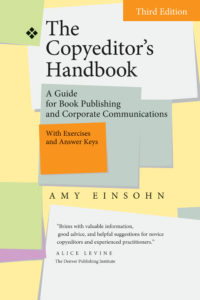 Sometimes my clients, often those who have worked with me before, can be clear from the outset about the kind of editing they are looking for, but generally speaking, their needs become clear through a dialogue at the beginning of the process.
Sometimes my clients, often those who have worked with me before, can be clear from the outset about the kind of editing they are looking for, but generally speaking, their needs become clear through a dialogue at the beginning of the process.
It is very helpful at that point to have some terms and editing concepts in common. Editors will often refer to light, medium and heavy copyediting. I’ll give you a rough sketch of what they mean by these terms. Every editor will have a personal take, but in the industry there is enough general consensus for them to be in common use. I’m indebted to The Copyeditor’s Handbook, 3rd edition, by Amy Einsohn, for a succinct exposition of these terms. If you are an editor, or are interested in editing, and don’t have this book – get it. You can click on the image for more information.
In a light edit, the editor will deal with all mechanical issues – spelling, punctuation, capitalization, etc. – and with outright grammatical errors. The editor won’t revise paragraphs for wordiness or convoluted language, but will point out such issues. Factual inconsistencies and possibly incorrect statements will also get noted in a light edit.
In a medium edit, the editor will of course address all the issues addressed by a light edit. In addition, they will point out awkward syntax, wordiness, and convolution – suggesting and supplying revisions. At the medium editing level, the editor will also begin to address questions of structure and logic – noting and querying only, however.
In a heavy edit, the editor will go ahead and revise what was queried or noted in a light or medium edit, rewriting convoluted or wordy sections, revising incorrect facts, and fixing poor organization.
While these are rough categories, they provide valuable reference points as you develop understanding with your editor.
No Comments